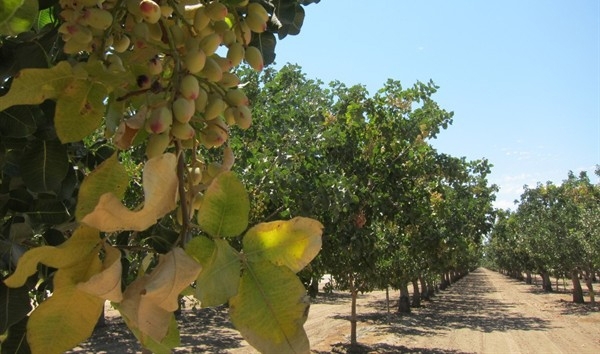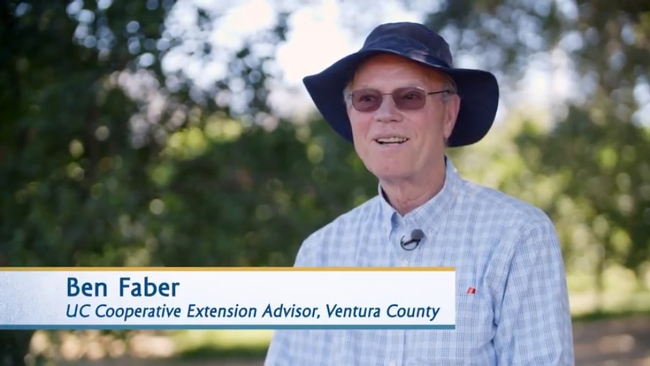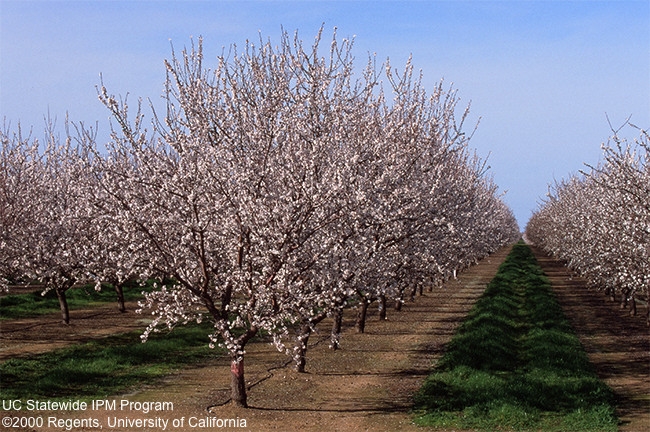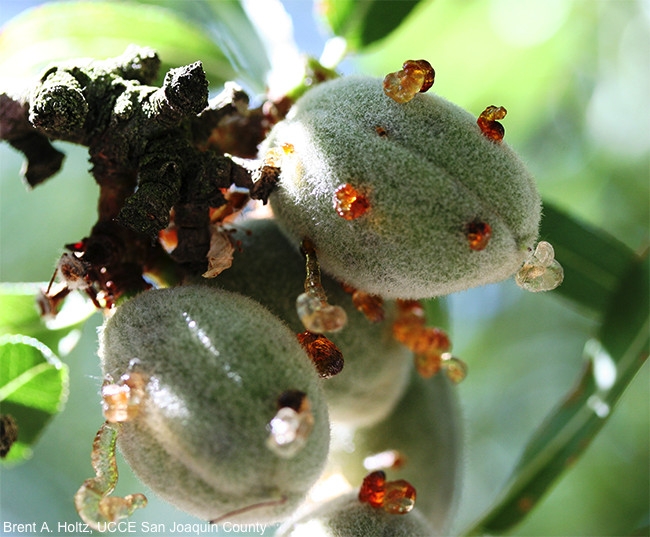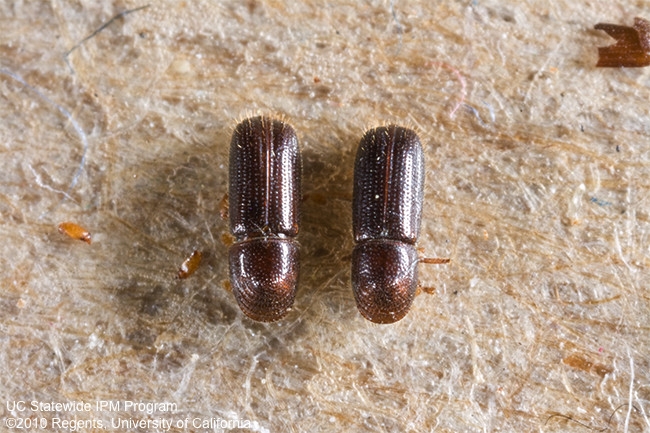Posts Tagged: Almonds
Climate and California agriculture of the future
One of the forces driving agricultural experiments in California's fertile San Joaquin Valley is climate change, reported Mark Schapiro on Grist.org. Although some sources still don't feel completely comfortable with the concept.
"Whether it's carbon built up in the atmosphere or just friggin' bad luck, the conditions are straining us," said John Duarte, president of Duarte Nursery.
The state's fruit and nut orchards are taking the most heat as conditions change. A fruit or nut tree planted today may be ill-suited to climatic conditions by the time it begins bearing fruit in 5 or 10 years. Between 1950 and 2009, “chill” hours trees needed annually to reboot trees' metabolic system for the spring bloom had already declined by as much as 30 percent, according to a California Department of Food and Agriculture study.
“If trees haven't had that low-chill period when they wake up in the spring, it's like being up all night and then trying to go to work.” said Mae Culumber, a nut crop advisor with UC Cooperative Extension in Fresno County.
Researchers have already observed that cherry, apricot, pear, apple, pecan and almond trees are often less productive than they used to be.
The article said farmers may turn to pistachio trees to weather a warmer and dryer California. Pistachio trees require one-third to one-half as much water as almond trees. During droughts, pistachio tree metabolism slows and when water returns, they start producing nuts again. And they can produce nuts for 80 years or longer, almost four times the life span of an average almond tree.
For field crops, scientists are looking at improving the soil and transforming growing systems to help farmers adapt to the warming climate.
“When I drive to the Central Valley, I get goosebumps; I feel the urgency,” UC Davis agronomist Amélie Gaudin said. “I see an agriculture that is basically hydroponics. It's like a person being fed/kept alive by an IV.”
“What happens when you no longer have the sugar-water?” she adds.
Gaudin is focusing on using agroecological principles to develop efficient and resilient cropping systems. Planting cover crops and reducing tillage show promise for mitigating the impact of climate change in the valley.
'A' is for Almonds and 'B' is for Bees and Bradford Pear Blossoms
No, it's not Valentine's Day, yet. Yes, the almonds are blooming. No, it's not spring. But it looks like spring in Benicia. The almonds are...
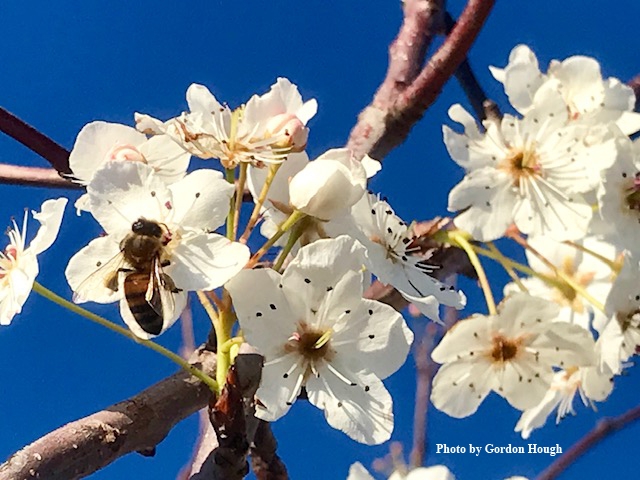
Benicia resident Gordon Hough captured this image of a bee nectaring on a Pyrus calleryana (Bradford pear or another cultivar) at the Benicia State Recreation Area on Monday, Jan. 21, as identified by Daniel Potter, UC Davis professor of plant sciences.
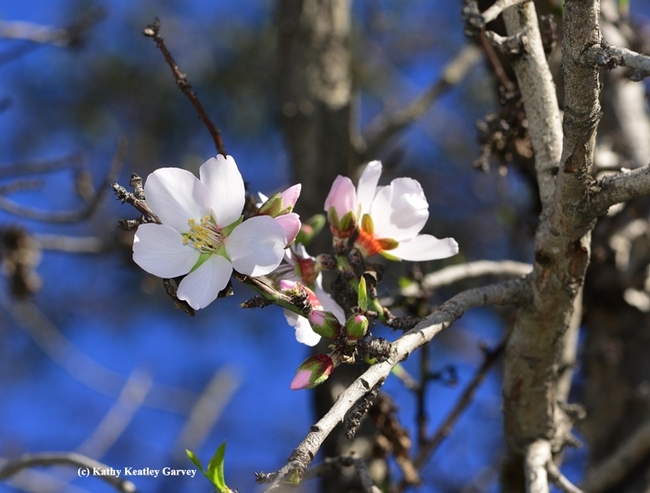
Almonds are blooming in Benicia. (Photo by Kathy Keatley Garvey)
Mandarin drought tips featured in final video of drought series
Because periodic droughts will always be a part of life in California, the UC California Institute for Water Resources (CIWR) produced a series of videos to maintain drought awareness and planning, even in years when water is more abundant.
The final video of the three-part series, which focuses on drought strategies for citrus, was launched April 6 on the UCTV Sustainable California channel. The first episode, which centered on alfalfa production, premiered Feb. 2 on the UCTV Sustainable California channel. The second video, on almonds, was launched March 2 on Sustainable California. A trailer with clips from all three episodes is here.
The videos are inspired by a collection of 19 drought tips produced by CIWR in collaboration with UC Agriculture and Natural Resources researchers during the drought of 2010-16. The tips cover a broad spectrum of California crops, from alfalfa to walnuts. Topics also include salt management, use of graywater in urban landscapes, and the use of shallow groundwater for crop production.
The drought tips collection and the drought tip videos were sponsored by the California Department of Water Resources. Following are links to each of the videos:
Drought strategies for alfalfa
The CIWR drought tip series opens with Cannon Michael of Bowles Farming in Los Banos. The alfalfa grower works with UCCE specialist Dan Putnam. “There's a lot of misunderstanding about alfalfa as a crop,” Michael said. “It does take water to grow it, as with anything, but you get multiple harvests of it every year.”
Drought management for California almonds
The second episode features almond producer Raj of Meena farms. He works with David Doll, UCCE advisor in Merced County. “One positive of this drought,” Meena said, “is that it has forced us all to be more efficient in how we use our water.”
Irrigating citrus with limited water
The series finale features Lisa Brenneis of Churchill-Brenneis Orchard in the Ojai Valley of Ventura County. She worked with UCCE advisor Ben Faber to install a new water-efficient irrigation system. “Irrigation is the only job we really have to do,” Brenneis said, “and we have to get it as right as we can.”
For a complete list of drought tips, see http://ucanr.edu/drought-tips.
Check out the Revised Almond and Walnut Pest Management Guideline
Writer/editor Cheryl Reynolds at UC Integrated Pest Management, just published this fantastic blog on the Revised Almond and Walnut Pest Management...
Almond and Walnut Pest Management Guidelines revised just in time for the holidays
‘Tis the season for baking lots of tasty treats. Breads, cookies, cakes, and candy are just a few that come to mind. What makes many of these treats so tasty is the addition of almonds or walnuts to the list of ingredients.
In California, we are lucky to be at the center of almond and walnut production. According to the California Department of Food and Agriculture's (CDFA's) latest Agricultural Statistics Review, more than 99 percent of the almonds and walnuts produced in the United States are grown in California.
Almond and walnut growers work tirelessly to supply enough nuts to not only satisfy domestic demand, but also for export. Worldwide, almonds rank as the largest specialty crop export. California is the top almond producer in the world, accounting for about 80 percent of all almonds grown. For walnuts, California ranks as the second largest producer in the world. To keep up with this demand, almond and walnut growers must be constantly aware of pests, diseases, and abiotic problems that can affect the tree and growing nuts.
The University of California Statewide Integrated Pest Management Program (UC IPM) has recently published revised Pest Management Guidelines for almonds and walnuts, helping growers prevent and manage pest problems with the most up-to-date information.
Revisions in the Almond Pest Management Guidelines include:
- A new section on bacterial spot, a new disease of almond in California found in the Sacramento and northern San Joaquin valleys
- A renamed section on fruit russeting, revised from the old powdery mildew section
- Significant revisions made to the management section of navel orangeworm, one of the major pests attacking California almonds
- Improvements on how to do dormant spur sampling section with easier-to-understand information on monitoring and thresholds
Revisions in the Walnut Pest Management Guidelines include:
- Updated information on the association between walnut twig beetle and thousand cankers disease
- New sections for Botryosphaeria and Phomopsis cankers, branch wilt, and paradox canker
- Significant changes to the walnut husk fly management section
Both the almond and walnut revised Pest Management Guidelines also include updated information on fungicide efficacy, weed management, and vertebrate management.
Authored by University of California specialists and advisors, the Pest Management Guidelines are UC's official guidelines for monitoring and managing pests in California crops. For more information on pest management in these or other crops, visit the UC IPM website.


